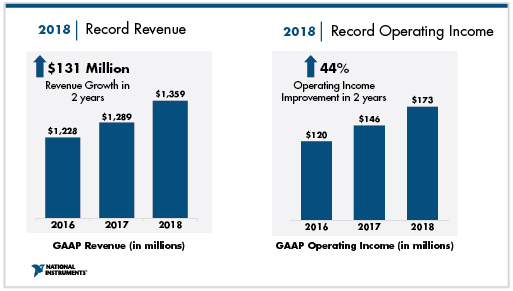A tax-qualified, employee-funded 401(k) plan. NI makes matching contributions under the plan inIn structuring these benefit programs, we seek to provide an amount equal to 50% of the amount of the employee’s contribution up to 6% of the employee’s base salary. The plan does not permit the purchase of shares of NI common stock.
Health and welfare benefits. Under this plan, the cost to NI is dependent on theaggregate level of benefits coverage an employee elects.
NI seeksthat are comparable to reward shorter-term performance through base salary, its annual bonus programs and its discretionary bonus program. Longer-term performance is incentivized through RSU grants and the service award program.those provided by similar companies.
Analysis of Elements of Executive CompensationPerquisites and Other Personal Benefits
Base Salary
NI’s goal isWe do not view perquisites or other personal benefits as a significant component of our executive compensation program. Accordingly, we do not provide significant perquisites or other personal benefits to provide its executives with competitive base salaries. NI uses independent survey information to help evaluateour Named Executive Officers. During 2018, none of our Named Executive Officers received perquisites or other personal benefits that were, in the reasonableness and competitiveness of its base salaries. NI determines base salaryaggregate, $10,000 or more for each executive based onindividual.
In the level of job responsibilities, consideration of the prior performance of the executivefuture, we may provide perquisites or other personal benefits in limited circumstances. All future practices with respect to perquisites or other personal benefits will be approved and the company, the executive’s experience and tenure, consideration of the expected future contributions of the executive, the business risk presented to NI in the event the executive were to leave the employ of the company, and general compensation trends and practices in the technology industry, including pay levels and programs provided by comparable companies. In setting base salaries, NI does not utilize any particular formula but instead exercises judgment in view of its overall compensation philosophy and objectives. Individual base salaries are reviewed annually. After consideration of the factors described above, Mr. Rust received a base salary increase of 7.7% in February 2015 in connection with his promotion to Senior Vice President, Global Research and Development to adjust his salary to be more in line with the Radford survey data and an increase of 7.5% in October 2015 in connection with the annual salary review process. Mr. Starkloff received a base salary increase of 6.7% in connection with the annual salary review process. At Mr. Davern’s request, he did not receive a salary increase in 2015. The overall NI employee base received a weighted average salary increase of 4.9%. The weighted average percentage increase was determined by taking the aggregate percentage increase in the base salaries of all employees as a group. At his request, our CEO receives a base salary of $1 per year.
Annual Company Cash Performance Bonus Program
NI maintains a cash performance bonus program under which substantially all regular full-time and part-time employees, including executives, participate (the “Annual Performance Bonus Program”). To receive a payout under the plan, NI must achieve pre-determined goals for revenue growth and profitability. These goals, as provided in the plan, were 40% year over year organic revenue growth and 18% non-GAAP operating profit as a percent of revenue. The same goals apply to all participants in the plan including executive and non-executive employees. The amount of the payments made under the Annual Performance Bonus Program is based on a bonus payment percentage multiplied by the eligible earnings of each participant. Eligible earnings include base salary, overtime pay and commissions but exclude bonuses, equity awards, relocation payments and previous cash performance bonus payments. The bonus payment percentage for executives was determined by multiplying 40% by two variables: NI’s actual organic revenue growth divided by the targeted level of revenue growth of 40%; and NI’s actual operating profit as a percentage of revenue divided by the target operating profit of 18%. The bonus payments percentage for non-executives was determined in the same manner except that the “multiplier” was 15% not 40%. Expressed as a formula, the bonus calculation for executives follows:
| | | | | | | | |
Calendar Year Organic Revenue Growth | | X | | Calendar Year Operating Profit
(not to exceed 18% for payout purposes)
| | X | | 40% = Bonus Percentage |
40% | | | | 18% | | | | |
For fiscal 2015, none of NI’s named executives received individual payments under the Annual Performance Bonus Program. Amounts under the Annual Performance Bonus Program are customarily made in two payments, one in the fourth quarter and the other upon completion of the annual financial statement audit in the first quarter of the following year.
Annual Incentive Program
NI maintains an AIP under which only officers and fellows participate. Dr. Truchard, NI’s President and Chief Executive Officer, does not participate in the program. Under this program, payments are made to executive officers based upon the achievement of individual performance criteria and NI business goals as approved by the NI Board and NI’s President. Program participants are designated by NI’s President and approved by the Compensation Committee. The participants under the AIP and the AIP goals are determined annually. The amount of cash bonus under the AIP ultimately paid depends on the extent to which the performance goals of each executive are achieved, in each case subject to adjustment at the discretion of the Compensation Committee.
The AIP is intended to increase stockholder value and promote NI’s success by providing incentive and reward for the accomplishment of key objectives by NI executives.
In February 2014, the Compensation Committee approved an amendment to the AIP to provide that incentive bonuses under the AIP are defined as a percentage (with a target of up to 60% for Executive Vice Presidents, a target of up to 30% for Senior Vice Presidents and a target of up to 20% for Vice Presidents and Fellows) of a participant’s salary (or, in the case of executives in the sales organization, salary plus targeted commission), based upon attainment of objectives approved in accordance with the AIP. For 2015, the target bonus under the AIP for each of Mr. Davern, Mr. Starkloff, and Mr. Rust was 60%, 40% and 30% of his base salary, respectively. Under the terms of the AIP (as amended), the actual bonus amount to be paid to AIP participants can be more or less than the target bonus based on the nature of the objectives, the performance of the participant relative to such objectives and the discretion of the Compensation Committee. For the purposes of the AIP, the base salary amount to be used is set by the Compensation Committee at the time the goals are approved. Payments are made based on whether the individual executive has achieved his or her specified objectives for the year. Each executive typically has four to six objectives that are targeted to reward achievements in the executive’s functional area or NI business goals. The objectives for NI’s executive officers are presented to and approved by NI’s President and then submitted for approval each year to the NI Board. The amount of the bonus for an executive officer which is allocated to each specific objective is approved each yearperiodic review by the Compensation Committee.
With respectEmployment Arrangements and Post-Employment Compensation
We have entered into a written employment agreement with our CEO and have written employment offer letters with certain of our other Named Executive Officers. In filling each of our executive positions, we recognized the need to NI’sdevelop competitive compensation packages to attract qualified candidates in a dynamic labor market. At the same time, in formulating these compensation packages, we were sensitive to the need to integrate new executive officers into the executive compensation structure that we were seeking to develop, balancing both competitive and internal equity considerations. Each of these arrangements provides for “at will” employment.
The terms and conditions of employment of Mr. Davern and Mr. Starkloff as set forth in their written employment agreement or offer letters, also contain post-employment compensation arrangements that provide them with certain protection in the event of their termination of employment under specified circumstances, including following a change in control of NI. We do not have specific post-employment compensation arrangements in place with any of our other Named Executive Officers. However, the endterms of NI’s fiscal year, NI’s PresidentMs. Rapp’s and Mr. Rust’s employment provide for acceleration of certain RSUs in the Compensation Committee meet to determine whether the objectivesevent of each executive officer were attained and then approve or disapprove the paymenttheir terminations under certain circumstances. Each of our Named Executive Officers have PRSUs under our 2015 Incentive Plan with special vesting terms upon a change in control as further described below. For detailed descriptions of the annual incentive amounts based upon the achievement of such objectives and the discretion of NI’s President and the Compensation Committee. NI’s President and the Compensation Committee, acting together, have the discretion to pay all or a portion of an amount to an AIP participant even if such participant did not meet a particular objective if the President and the Compensation Committee believe that such payment is appropriate to achieve the objectives of the program. However, no discretion was applied by the Committee to the payment of AIP bonuses to named executive officersemployment arrangements we maintained with our Named Executive Officers for achievement of AIP objectives for 2015.
For fiscal 2015, NI made cash bonus payments to named executives under the AIP that ranged from approximately $27,377 to $125,087 per executive.
Under the AIP, the Compensation Committee has the discretion to make payments of any cash incentive bonus in the fourth quarter of the calendar year based upon projected achievement levels (“Estimated Payment”) rather than waiting until the following calendar year. The payment of an Estimated Payment is subject to reconciliation after NI’s books have been closed and audited. If the Estimated Payment is less than the final amount due to the AIP participant, an additional payment equal to the amount of the shortfall is made to such participant. If the Estimated Payment is more than the final amount due to the AIP participant, such participant shall remit to NI the amount of the overpayment. For fiscal 2015, no such Estimated Payment was made.
The tables below set forth the performance criteria, potential awards and actual awards under the AIP2018 as well as the weightings assigned to the objectives for 2015 for eachan estimate of the named executives, except Dr. Truchard, NI’s Presidentpotential payments and Chief Executive Officer, who does not participate in the program:benefits payable under these arrangements, see “Potential Payments Upon Termination or Change of Control” below.
2015 ANNUAL INCENTIVE PROGRAM GOALS AND AWARDS
FOR THE NAMED EXECUTIVES
| | | | | | | | | | | | |
Alexander Davern, Chief Operating Officer, Chief Financial Officer, Executive Vice President and Treasurer | |
| 2015 Officer Bonus Goals (1) | | % Goal Weighting | | | Goal Value (2) | | | 2015 Actual
Payout | |
1) Achieve targeted revenue growth goals | | | 30 | % | | $ | 99,000 | | | $ | 0 | |
2) Achieve operating margin goal | | | 30 | % | | $ | 99,000 | | | $ | 0 | |
3) Achieve gross margin goal | | | 15 | % | | $ | 49,500 | | | $ | 38,250 | |
4) Ensure expenses are within budget | | | 15 | % | | $ | 49,500 | | | $ | 49,500 | |
5) Achieve cost reduction target | | | 10 | % | | $ | 33,000 | | | $ | 37,337 | |
| Total | | | 100 | % | | $ | 330,000 | | | $ | 125,087 | |
(1) | NI is not disclosing the specific target levels with respect to performance goals because such information represents confidential trade secrets or confidential commercial or financial information, the disclosure of which would cause NI competitive harm. The performance goals were set to be moderately difficult, or stretch goals, but not unachievable. |
(2) | The goals in items 1), 2) and 5) above contain incremental payout thresholds and an increased payout if actual results attained exceed the targeted 100%. In such instance, the maximum amount payable to Mr. Davern would be $390,500. |
| | | | | | | | | | | | |
| Eric Starkloff, Executive Vice President, Global Sales and Marketing | |
| 2015 Officer Bonus Goals (1) | | % Goal Weighting | | | Goal Value (2) | | | 2015 Actual
Payout | |
1) Achieve targeted revenue growth goals | | | 35 | % | | $ | 52,500 | | | $ | 0 | |
2) Achieve platform adoption goals | | | 20 | % | | $ | 30,000 | | | $ | 33,750 | |
3) Achieve targeted opportunity generation goals | | | 25 | % | | $ | 37,500 | | | $ | 27,908 | |
4) Achieve operating margin goal | | | 10 | % | | $ | 15,000 | | | $ | 0 | |
5) Ensure expenses are within budget | | | 10 | % | | $ | 15,000 | | | $ | 11,250 | |
Total | | | 100 | % | | $ | 150,000 | | | $ | 72,908 | |
(1) | NI is not disclosing the specific target levels with respect to performance goals because such information represents confidential trade secrets or confidential commercial or financial information, the disclosure of which would cause NI competitive harm. The performance goals were set to be moderately difficult, or stretch goals, but not unachievable. |
(2) | The goals in items 1), 2) and 4) above contain incremental payout thresholds and an increased payout if actual results attained exceed the targeted 100%. In such instance, the maximum amount payable to Mr. Starkloff would be $170,625. |
| | | | | | | | | | | | |
| Scott Rust, Senior Vice President, Global Research & Development | |
| 2015 Officer Bonus Goals (1) | | % Goal Weighting | | | Goal Value (2) | | | 2015 Actual
Payout | |
1) Achieve targeted revenue growth goals | | | 55 | % | | $ | 50,655 | | | $ | 0 | |
2) Achieve operating margin goal | | | 10 | % | | $ | 9,210 | | | $ | 0 | |
3) Achieve platform adoption goals | | | 15 | % | | $ | 13,815 | | | $ | 15,542 | |
4) Ensure expenses are within budget | | | 10 | % | | $ | 9,210 | | | $ | 9,210 | |
5) Achieve quality goals | | | 10 | % | | $ | 9,210 | | | $ | 2,625 | |
Total | | | 100 | % | | $ | 92,100 | | | $ | 27,377 | |
(1) | NI is not disclosing the specific target levels with respect to performance goals because such information represents confidential trade secrets or confidential commercial or financial information, the disclosure of which would cause NI competitive harm. The performance goals were set to be moderately difficult, or stretch goals, but not unachievable. |
(2) | The goals in items 1), 2) and 3) above contain incremental payout thresholds and an increased payout if actual results attained exceed the targeted 100%. In such event, the maximum amount payable to Mr. Rust would be $108,678. |
In assessing performance against the objectives for each named executive participating in the AIP, NI’s PresidentWe believe that these protections were necessary to induce these individuals to accept their positions. We also believe that these arrangements help maintain their continued focus and dedication to their assigned duties to maximize stockholder value. The Board considered the actual results for 2015 against the specific deliverables associated with each objective, the extent to which the objective was a significant stretch goal for the organization, and whether significant unforeseen obstacles or favorable circumstances altered the expected difficulty in achieving the desired results. Based on the foregoing factors, NI’s President recommended, and the Compensation Committee approved, a cash payment for each named executive. As set forth under the column heading “2015 Actual Payout,” the actual payouts to NI’s named executive officers ranged from 25% to 43% of the maximum amount they were eligible to receive under the AIP in 2015.
Sales Commission Program Applicable to Executive Vice President, Global Sales & Marketing. On January 27, 2015, the Compensation Committee approved a bonus arrangement for Mr. Starkloff, NI’s Executive Vice President, Global Sales and Marketing. Under this arrangement, Mr. Starkloff is eligible to receive a cash bonus of $12,500 per quarter if NI’s quarterly revenue equals 100% of the targeted amount for such quarter. If NI’s revenue for a quarter is less than the targeted amount, the total bonus amount for that quarter will decrease provided that no bonus amount is payable for the quarter unless NI’s revenue for the quarter exceeds the minimum threshold amount for such quarter. If NI’s revenue for a quarter exceeds the targeted amount for that quarter, the total bonus amount for the quarter will increase up to a maximum of $25,000 per quarter. NI is not disclosing the specific targets or threshold amounts with respect to such bonus arrangement because such information represents confidential trade secrets or confidential commercial or financial information, the disclosure of which would cause NI competitive harm. The targeted revenue amounts were set to be a moderately difficult stretch goal, but not unachievable. Under this sales bonus plan, Mr. Starkloff earned for 2015 an aggregate of $46,934, which represented approximately 94% of the targeted annual amount.
Discretionary Cash Bonus Program
NI maintains a discretionary cash performance bonus program under which all employees, including executives, are eligible to receive awards in recognition of performance or a special achievement that is not covered by NI’s other compensation programs. Awards under this program vary based on the nature of the recognition event. The amount of the award for executives is determined by NI’s President and the amount of the award for non-executive employees is determined by the departmental supervisors. The average award under this program in 2015 was approximately $1,208. During 2015, none of the named executives received an award under this program. NI’s President does not participate in this program.
Restricted Stock Unit (RSU) Awards
Determining the Overall Level of Equity Compensation Awards. NI uses equity compensation to incentivize key employees. In 2015, approximately 35.2% of all U.S. based regular, full-time professional employees received equity based compensation. NI’s use of stock based equity compensation for its employees is driven by NI’s goal of aligning the long-term interests of its employees with its overall performance and the interests of its stockholders. NI’s equity compensation program is also driven by NI’s desire to be sensitive to the dilutive impact that such equity compensation will have on its stockholders.
Allocation of Equity Compensation Awards. In 2015, NI granted a total of 951,265 RSUs to all employees, which represented 0.75% of NI’s shares outstanding at December 31, 2015. Of such amount, a total of 65,000 RSUs were granted to NI’s named executives in April 2015, representing 6.8% of all RSUs granted in 2015.
RSUs granted to executives vest over a period of ten years, subject to acceleration based on NI’s performance. For 2015, these executive RSU grants were subject to an additional performance-based goal that required that during the period beginning April 1, 2015 and ending June 30, 2015, NI’s non-GAAP operating income divided by NI’s net sales had to be equal to or greater than a target percentage, and if such target was not met, all of the RSUs subject to such executive awards would be forfeited. Based on NI’s actual performance for such period, the performance goal was met and the RSUs will vest in accordance with the other vesting provisions of such award. The foregoing performance-based goal was established to meet the requirements of Section 162(m) of the Internal Revenue Code of 1986, as amended (the “Code”). Expressed as a formula, the acceleration amount for RSU grants under the 2010 Plan to executives is as follows:
| | | | | | | | | | | | |
Calendar Year Organic
Revenue Growth | | X | | Calendar Year
Operating Profit
(not to exceed 18% for payout purposes)
| | X | | Shares
Granted
| | = | | Shares Accelerated |
40% | | | | 18% | | | | 10 | | | | |
Expressed as a formula, the acceleration amount for RSU grants to executives under the 2015 Plan is as follows:
| | | | | | | | | | | | |
Calendar Year Organic
Revenue Growth | | X | | Calendar Year
Operating Profit
(not to exceed 18% for payout purposes)
| | X | | Shares
Granted
| | = | | Shares Accelerated |
20% | | | | 18% | | | | 10 | | | | |
A set formula for allocating RSUs to the executives as a group or to any particular executive is not utilized. Instead, the Compensation Committee exercises its judgment and discretion and considers, among other things, the role and responsibility of the executive, competitive factors, labor market dynamics, the relative importance of retaining each executive, the amount of stock based equity compensation already held by the executive, the non-equity compensation received by the executive and the total number of RSUs to be granted to all participants during the year.
Timing of Equity Awards. The Compensation Committee typically grants RSUs to executives and current employees once per year. Such grants are made at a meetingrecommendation of the Compensation Committee heldand reviewed the proposed terms of these arrangements and deemed it to be in the second quarterbest interests of NI and its stockholders to approve the year. RSU grantsterms of such arrangements.
We do not use excise tax payments (or“gross-ups”) relating to new employees were issued five timesa change in 2015 at Compensation Committee meetings.control of NI does notand have no such obligations in place with respect to any program, plan or practice to time RSU grants in coordination with the release of material non-public information. NI does not time, nor does NI plan to time, the release of material non-public informationour Named Executive Officers.
In addition, our equity compensation plans provide for the purposesacceleration of affectingvesting of outstanding and unvested equity awards in certain circumstances. Specifically, the value of executive compensation.
Executive Equity Ownership. NI’s President and Chief Executive Officer, Dr. Truchard, is NI’s largest stockholder. NI encourages its executives to hold a significant equity interest in NI. However, NI does not have specific share retention and ownership guidelines for its executives. NI does not permit executives to sell short its securities. NI prohibits named executives from holding NI securities in a margin account and prohibits the purchase or sale of exchange traded options on its stock by executives.
Type of Equity Awards. Prior to 2005, the long-term equity incentive component of NI’s compensation program consisted solely of stock options. Beginning in 2005, NI began to utilize RSUs as its principal equity compensation incentive. Under the expired 2010 Incentive Plan, NI was permitted to issue RSUs and restricted stock but not stock options. On May 12, 2015, the stockholders approved the 2015 Incentive Plan, including approval of its material terms and performance goals for purposes of Internal Revenue Code Section 162(m). The NI Board of Directors had approved the 2015 Incentive Plan on January 28, 2015, subject to stockholder approval. The 2015 Incentive Plan provides for the grant of restricted stock and RSUs. Those eligible for awards under the 2015 Incentive Plan include NI employees, directors and consultants and employees and consultants of any parent or subsidiary of NI.
Service Award Program
NI maintains a service award bonus program under which all employees, including executives, are eligible to receive awards based on the number of years of continued employment with NI. NI’s President does not participate in the program. Under this program, upon achieving a five-year period of continuous employment with NI, an employee receives a cash award and a $100 dinner gift certificate, as well as other non-monetary awards such as a plaque or lunch with NI’s President, Vice President of Human Resources or another NI executive. Awards under this program have historically been in the range of $100 to $1,000 in cash per award, with employees receiving $100 in cash at their 5th anniversary of service with NI and $1,000 in cash at their 10th, 15th, 20th and 25th anniversaries of service with NI.
During 2015, one of the named executives, Mr. Rust, received an award of $1,000 under this program for having reached 25 years of employment with NI.
Performance Based Compensation and Financial Restatement
To date, NI has not experienced a financial restatement and has not implemented a policy regarding retroactive adjustments to any cash or equity based incentive compensation paid to its executives and other employees where such payments were predicated upon the achievement of certain financial results that would subsequently be the subject of a restatement.
Change of Control Considerations
All NI executives are employed at will and do not have employment agreements, severance payment arrangements or payment arrangements that would be triggered by a merger or other change of control of NI. The 2005 Incentive Plan and the 2010 Incentive Plan provide that in the event of a change of control of NI, all outstanding and unvested RSUsRSU awards held by executive and non-executiveour employees, shallincluding our Named Executive Officers, will immediately vest in full. UnderFurther, under the 2015 Incentive Plan, in the event of a change in control of NI, all outstanding and unvested equity awards will be treated as determined by the plan administrator, including that each award be assumed or substituted by the successor corporation; provided, however, that, in the event the successor corporation does not assume or substitute for the awards, the restriction period of any award of restricted stock or RSUs shallRSU award will immediately be accelerated and the restrictions shallwill expire.
























